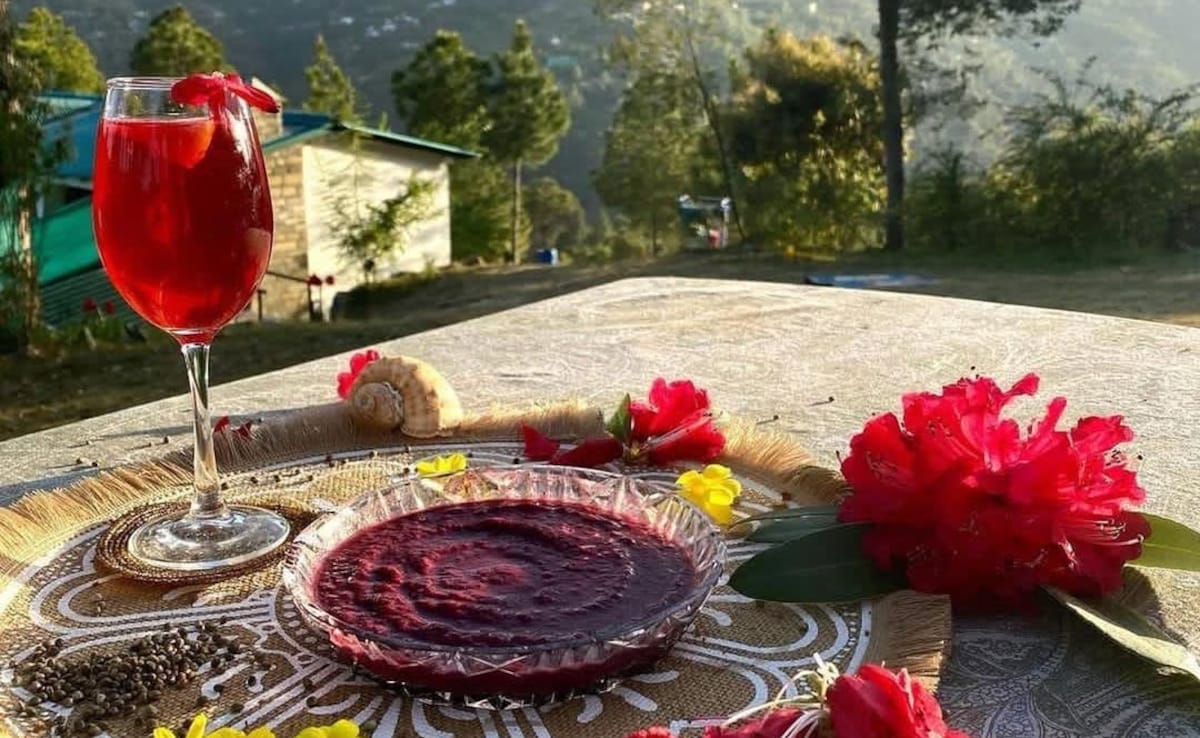
Every spring, as winter loosens its grip on the Himalayan foothills, Uttarakhand erupts in a riot of red, pink, and white. Rhododendron — known locally as buransh — isn't just a pretty bloom here. It's woven into the rhythm of daily life, influencing everything from street snacks to forest hikes. If you're planning a spring getaway and want to skip the usual tourist trail, timing your trip with rhododendron season in Uttarakhand might be the best decision you make. Running from late February to early April, rhododendron season offers more than scenic Instagram backdrops. Here's how to experience it the local way-with flavour, folklore, and a little bit of altitude.
Also Read: Where To Chase Cherry Blossoms In India This Season
Here's How To Celebrate The Rhododendron Season In Uttarakhand Like Locals:
1. Sip Buransh Juice From A Hill-Side Stall
Start your rhododendron rendezvous the way locals do — by sipping a chilled glass of buransh juice. This tart, ruby-red drink is made from the petals of Rhododendron arboreum, the state flower of Uttarakhand. Rich in antioxidants and believed to boost heart health, it's a staple across roadside dhabas in Garhwal and Kumaon. Look for stalls in Mussoorie, Nainital, and Ranikhet where juice is sold in recycled glass bottles and often paired with pakoras for maximum mountain vibes.
2. Try Buransh Chutney At A Homestay

Photo: Instagram/happydervishhomestay
If you're staying at a family-run guesthouse in villages like Kanatal, Almora, or Binsar, ask your host if they make buransh chutney. Each household has its own version — some spicy, some sweet, some with hints of jaggery or lemon. It's usually served with millet rotis or rice and is a true taste of local culture. Many families forage the flowers themselves, drying them in the sun before blending them with traditional spices.
3. Catch A Rhododendron Festival (Yes, That's A Thing)
The annual Buransh Mahotsav is held in places like Pauri and Tehri to celebrate the flower's cultural and economic importance. Think folk dances, petal-infused dishes, handicrafts, and even beauty products made from rhododendron extract. The vibe is more rural fair than tourist trap — and that's exactly what makes it special. Dates vary, so check with local tourism offices in March.
4. Hike The Rhododendron Trails Of Chopta And Munsiyari

Photo: Instagram/_tushar.gupta_
While valleys like Yumthang in Sikkim are known for their blooms, Uttarakhand's lesser-known trails are equally stunning — and blissfully less crowded. The forests around Chopta, Tungnath, and Munsiyari transform into shades of crimson and coral in March. These trails aren't manicured; they're earthy, aromatic, and occasionally steep. Hire a local guide who knows where the best blooms are and can also point out edible herbs and wild berries along the way.
Also Read: 6 Offbeat Weekend Getaways From Rishikesh That Are Worth Escaping To
5. Shop For Handmade Buransh Souvenirs
Move over mass-produced souvenirs. In villages around Joshimath and Uttarkashi, women-led self-help groups create artisanal products using dried rhododendron petals — think syrups, jams, squashes, and even lip balms. Buying these not only supports local livelihoods but also gives you a unique gift to take back home (way cooler than a fridge magnet).
6. Join A Village Walk With Local Storytellers

Photo: Instagram/himalayan_wings
Several community-run tourism initiatives, especially around Almora and Pithoragarh, offer guided village walks where locals talk about how rhododendrons have shaped everything from local medicines to folklore. Some even take you to see how the flowers are harvested and processed. It's a slower, more thoughtful way to travel — and a great way to chat with people who actually live in the landscapes we so often just pass through.
7. Camp Under Blooming Canopies
Forget hotels for a night and pitch a tent near rhododendron groves in places like Khirsu or Chakrata. Local tour operators offer guided camping experiences complete with bonfires, basic meals, and sunrise treks through flower-laced forests. It's the kind of unplugged mountain moment that's becoming harder to find. Just make sure you carry out everything you carry in — these forests are delicate ecosystems.
Track Latest News Live on NDTV.com and get news updates from India and around the world

